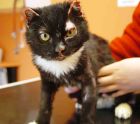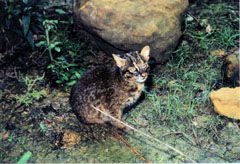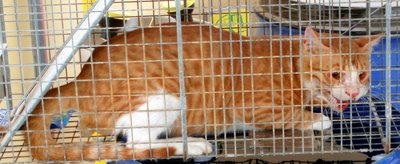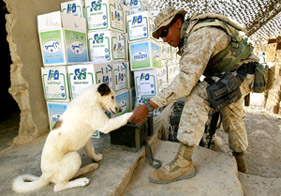
"To have known, at close quarters, what absolute evil means is to be armored against what life can do to you."
-- Agatha Christie, The Third Girl
This is a call to arms for all cat lovers.
For all too many years cat advocates have stood placidly by while bird lovers have vilified, abused, and murdered cats. The American Bird Conservancy (ABC) has lobbied hard to have them placed under house arrest. The National Audubon Society, National Wildlife,
National Geographic, PETA, and others have been so brazen as to call for the roundup and extermination of all feral cats.
(See Cat Defender post of April 15, 2005 entitled "National Geographic Trying to Exterminate Cats.")
Monsters like Richard DeSantis in West Islip, Long Island and Debbie and Robert McCallum of Edmonds, Washington have illegally trapped their neighbors' cats and turned them over to shelters to exterminate.
(See Cat Defender posts of June 15, 2006 and October 30, 2006 entitled, respectively, "Serial Cat Killer on Long Island Traps Neighbors' Cats and Then Gives Them to Shelter to Exterminate" and "Collar Saves a Cat Named Turbo from Extermination After He Is Illegally Trapped by Bird-Loving Psychopaths.")
Just as birds of a feather have a tendency to flock together, cat-hating bird enthusiasts and wildlife proponents are kindred spirits.
Par exemple, Pat Conrad, a fan of sea otters, wants all feral cats to be killed as does snake lover Paul Klawinski of William Jewel College in Liberty, Missouri.
(See Cat Defender posts of March 3, 2006 and May 16, 2006 entitled, respectively, "Cat-Hating Professor at UC-Davis and the BBC Call for the Extermination of 78 Million Feral Felines" and "Kansas City Vets Break Ranks with AVMA to Defend Cats Against Bird Advocates, Wildlife Proponents, and Exterminators.")
In Washington State, wildlife officials refuse to lift a finger to stop raccoons and coyotes from invading residential neighborhoods and killing cats.
(See Cat Defender posts of August 28, 2006 and October 2, 2006 entitled, respectively, "Marauding Pack of Vicious Raccoons Rip Ten House Cats to Shreds and Terrorize Residents but Wildlife Officials Refuse to Intervene" and "Coyotes, Cheered on by Wildlife Officials, Join Raccoons in Killing Cats and Dogs in Washington State.")
If all of that were not bad enough, the United States military has taken it upon itself to kill every cat that it sees as it spreads murder and mayhem around the globe.
(See Cat Defender post of November 14, 2006 entitled "Military Killing Cats and Dogs by the Tens of Thousands as Imperialistic America Attempts to Conquer the World.")
Bird advocates continue, however, to be cats' most diabolical and unscrupulous opponents. The latest and most egregious outrage against cats has been committed by Galveston, Texas bird lover Jim Stevenson
(See photo above) who was arrested on November 8th for murdering a pregnant cat with a .22 rifle near the San Luis Pass Bridge. Worst still, the cat already had a limp from a gunshot wound to the foot earlier in the week that was no doubt also inflicted by Stevenson.
Although it is not known exactly how many cats reside near the bridge, at least ten of them have been gunned down during the past year. Four were killed during the first week of November alone. Like all murderous fascists, Stevenson just either did not know when to quit or thought that he was immune to capture.
In all likelihood the fifty-three-year-old former high school teacher from Tallahassee would still be at it if it were not for the intervention of toll collector John Newland. Knowing that the game was up, Stevenson complied with Newland's order to stop shooting but like the yellow-bellied coward that he is he got in his truck and fled.
Newland then got in his pickup truck and eventually was able to run down the murderer. Stevenson then rammed Newland's truck with his own vehicle and took to his heels but by that time the police had arrived and he was promptly arrested.
Newland and co-worker Howard Etzel have names for each of the cats
(See photo below) that live near the bridge and consider them to be pets. They feed them and bury the bodies of Stevenson's victims underneath the span.
"I can't talk about it. I'm almost afraid to get them too tame because they trust people and people like this morning come out here and shoot them," Newland told KHOU-TV in Houston on November 8th. (
See "Prominent Bird Expert Charged With Shooting Cat.") "They're just like family. I told my wife that when I die, I want my ashes to be buried here under the bridge
(See photo below) so I can protect the cats," he added.
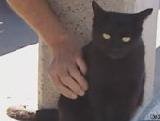
Etzel, meanwhile, was puzzled by Stevenson's killing spree. "Somebody like that just has to hate animals," he told KHOU-TV. "How can he be a birdwatcher and then hate cats? I don't know."
Compounding matters further, this is not a story simply about the murder of one cat or of ten cats.
Au contraire, Stevenson's murder spree dates back at least ten years and involves hundreds of cats. In particular, in a January 21, 1999 post on a website maintained by the University of Houston (listserv.UH.edu) he confesses to being a mass murderer of cats. The pertinent part of his anti-cat screed declares: "... I sighted my .22 rifle and killed about two-dozen cats in about the first year."
Any simpleton can crunch the numbers. If this diabolical monster is gunning down at a minimum twenty-four cats per year he must have killed at least two-hundred-forty of them over the past decade. The figure could actually be ten times that because he admits in the same post that he has also trapped cats. Moreover, if he is shooting and trapping felines he is also most likely poisoning them as well.
The web post reveals Stevenson to be an egomaniacal psychopath who is totally incapable of differentiating between right and wrong and truth and falsehood. He first of all makes the ludicrous claim that cats do not belong outdoors because they are not a natural part of the environment. Where did they come from then? Was it from outer space or a test tube?
As any fool knows, not only have there always been feral and stray cats but even most domestic cats have always lived outdoors. Historically, cats have been kept primarily at home and on farms as mousers; confining them to apartments as pets is a relatively new development that is practiced almost exclusively in crowded urban areas.
After than inauspicious beginning, he proceeds to blame the feline species for causing "innocent" motorists to feel "pain and guilt" when they run them down in the street. No one but either an inveterate cat-hater or a complete idiot would ever make such an absurd statement. Far from feeling remorse, motorists run down cats, dogs, and even Stevenson's precious birds for the thrill of doing so.
Not only are cats extremely cautious but they are also fleet of foot; consequently, any motorist behind the wheel of a car equipped with an advanced suspension system, good tires, and properly working brakes has to go out of his or her way in order to kill a cat or any other animal for that matter. The same is true of the five-thousand pedestrians that motorists annually slaughter each year across the country. Of course, in Stevenson's case he
sans doute steps on the accelerator and turns the wheel over every time he sees a cat crossing the street.
He next claims that by gunning down defenseless cats he is actually doing them a favor. "My only aim (so to speak) is to kill them without much pain, but this would pale in comparison to the pain they die with from diseases and starvation (which eventually happens to many feral cats)." Statements like that leave little doubt that he would gladly apply his perverted morality to all animals and individuals that he dislikes.
He also lamely attempts to justify his killings by claiming that he shoots only wild cats and those without collars. Newland's and Etzel's statements prove that he is lying about not killing tame cats and collars are difficult to detect from rifle range. It is quite obvious that he simply hates all cats and does not care about their status. For instance, when has any cat-hating bird lover ever restrained from attacking domestic cats?
He caps off his virulent spiel by calling upon PETA to trap and take care of all feral and stray cats. In doing so, he is obviously either being ironic or showing his stupidity because, like him, PETA also wants to kill all homeless cats. In fact, at its Norfolk, Virginia shelter it has a kill rate of around eighty-five
per cent.
The fact that a serial cat killer could operate for so long and in the open raises serious questions not only about the lax law enforcement in Galveston but also the commitment and vigilance of cat advocates both locally and nationally.
(See Cat Defender post of October 27, 2006 entitled "Tiny Kitten Named Zoe Has Her Ears Cut Off by Fiends but Texas Police Do Not Seem to Care.")

If either group had been doing its job, Stevenson would have been caught and put away a long time ago and hundreds of cats would still be alive today. Their dereliction of duty makes Newland's heroics all the more laudable.
Stevenson, who spent a night in the can, is back out on the street after posting a $10,000 bond. Even if convicted of felony animal cruelty, the severest sentence that he could receive would be between six and twenty-four months in the slammer and a measly $10,000 fine.
This slap-on-the-wrists penalty is so absurd that it is obscene. He should be tried for the deaths of two-hundred-forty cats and given four-hundred-eighty years in the stir. His online confession to shooting two-dozen cats should be sufficient alone to put him away for the remainder of his miserable existence. At the very least he should be charged with two counts of felony animal cruelty since his latest victim was pregnant. Even that is not about to happen, however. He will not only beat the rap but it is a lock that he will kill more cats in the future. His kind never changes.
Rather than condemning his killing spree, bird lovers, wildlife proponents, and shelter workers have jumped to Stevenson's defense. Among those quoted by the
Houston Chronicle in its November 11th edition as speaking up on his behalf were: Dori Nelson of the Seabrook Eco-Tourism Committee that he led on a recent birdwatching expedition; inveterate cat hater Trish McDaniel, former director of the Animal Shelter and Adoption Center of Galveston; Matt Wagner of the Texas Parks and Wildlife Department; and, Houston Audubon Society President Stennie Meadours.
(See "Birder Claims Past Cat Killings.")
None of these perverts actually had the fortitude to come right out and say directly that they approved of individuals gunning down cats but their derogatory comments about felines and their refusal to condemn the killings leaves little doubt that they are tickled pink about Stevenson's actions. No doubt they secretly wish that they had the
chutzpah to do what he has done. It will be interesting to see how much financial and legal assistance that they lend him at his upcoming trial. No doubt some of them will even testify on his behalf.
After devoting volumes of ink to Stevenson's supporters, the
Chronicle gave TNR practitioner Kathi Richardson only a few sentences to denounce Stevenson and to defend cats. Having read his anti-cat screeds in the
Galveston Ornithological Society magazine that he publishes, she said that his killing spree did not surprise her the least little bit.
As for the cats, she pointed out the often overlooked fact that their presence helps to keep down the rodent population. The cat-hating Australians recently ignored this
petit fait and as the result created an environmental disaster on Macquarie.
(See Cat Defender post of September 21, 2006 entitled "Aussies' Mass Extermination of Cats Opens the Door for Mice and Rabbits to Wreak Havoc on Macquarie.")
While cats do kill some birds and small mammals, they do not kill anywhere near the number that bird lovers and wildlife proponents allege. Moreover, if birders like Stevenson are so concerned about protecting birds they should fence in their nesting areas and stand guard over them twenty-four hours a day. That would allow them to humanely shoo away any felines that might venture near.
Although protecting birds is not the responsibility of cat owners, some of them have fenced in their yards and patios at great expense in order to protect wildlife. For instance, Julie Stonefelt of Edmonds, Washington spent several hundred dollars to enclose her cats Henry, Otis, and Oliver.
(See photo below of Henry and Otis). Fellow Edmonds resident Corrie Hines spent $3,000 on her enclosure.
(See The Herald of Everett, November 1, 2006, "Keeping Tabs on Tabbies.")

More to the point, birds are far from being innocent denizens of this planet. Eagles, owls, and other birds of prey attack and kill cats and kittens.
(See Cat Defender post of July 31, 2006 entitled "Fifteen-Year-Old Cat Named Bamboo Miraculously Survives Being Abducted and Mauled by a Hoot Owl in British Columbia.") Even blue jays and other songbirds harass cats, chipmunks, and other small animals.
Birds also foul streams with their excrement and thereby kill fish and other aquatic creatures. They also prey upon worms and other insects but no one has ever heard of any entomologist shooting birds although they would certainly be justified in doing so based upon Stevenson's twisted logic.
Birds also spread such deadly diseases as the West Nile Virus and
Vogelgrippe, start forest fires, foul storefronts, residences, and public parks with their droppings, and destroy crops. In this context it is important to remember that scarecrows are not erected in order to protect crops from cats and nobody has ever accused a cat of pooping on his or her head.
Birds also kill birds. This
petit fait was vividly demonstrated writ large last month when a Eastern White pelican ate a pigeon
(See photo below) in London's St. James Park.
(See BBC, October 25, 2006, "Pelican Swallows Pigeon in Park.")
Contrary to what birders and wildlife proponents would have the public believe, cats are the least of their worries. Rats, foxes, snakes, and other animals also kill birds, but bird lovers do not go around shooting these species. Developers and polluters also kill birds by destroying their habitats but yet birders do not denigrate and assassinate them.
Tall buildings, communications towers, airplanes, and automobiles also kill birds but one seldom hears birders complain about them either. Moreover, nearly all bird advocates drive cars, travel by air, work in tall buildings, and use telephones, televisions, and other modern conveniences that rely upon communications towers.
By purchasing a rife and bullets, Stevenson is lending his financial support to the armaments' manufacturers who are providing the means for warring factions all over the world not only to expeditiously exterminate each other but also to kill off the animals and to destroy the environment.
(See Cat Defender posts of August 10, 2006 and October 12, 2006 entitled, respectively, "Death Toll Mounts for Cats and Other Animals Slaughtered and Left Homeless in Lebanon by Israeli War Criminals" and "A Few Hundred Cats and Dogs Are Airlifted Out of Lebanon but Cluster Bombs and an Oil Slick Continue to Kill Animals and Marine Life.") More importantly, he has moved far beyond mere ailurophobia to perpetrating unspeakable acts of violence that no cat lover can possibly ignore.
Climate change is killing the famous flamingos in Kenya's Lake Nakura National Park but very few bird enthusiasts are willing to stop burning the fossil fuels that are accelerating global warming.
(See Environmental News Network, November 16, 2006, "African Lake's Iconic Birds Are Vanishing.")
Moreover, it is the Center for Biological Diversity rather than bird lovers that is suing the U.S. Fish and Wildlife Service in an effort to force that agency to comply with the Endangered Species Act by safeguarding fifty-six species of birds and five species of butterflies that are imperiled.
(See Environmental News Network, November 16, 2006, "Center Seeks Protection for Fifty-Six Vanishing Birds and Five Imperiled Butterflies Around the World.")
None of this is difficult to understand. The truth of the matter is that bird lovers are simply too busy murdering and denigrating cats to be bothered with protecting the birds that they so fervently claim to love. Their only
raison d'etre is to kill cats.

Logic and moral considerations are, of course, completely lost on bird advocates; no one can reason with psychopaths. Their resourcefulness and their penchant to take the law into their own hands must not, however, be underestimated. They are, in fact, far more dangerous than those New Jersey teens who burned a kitten to death for the fun of it.
(See Cat Defender post of October 5, 2006 entitled "New Jersey Teens' Idea of Fun: Beat Up a Defenseless Kitten and Then Burn It to Death.")
The teens' crime was an isolated incident, but the campaign of denigration and extermination launched against cats by birders is well-financed, systematic, and violent. Birders are cut from the same piece of cloth as people who shoot up schoolhouses and post offices and blow up federal office buildings such as the one in Oklahoma City. They have zero tolerance for those who oppose them and they are not the least bit hesitant to resort to violence. Homeland Security needs to start monitoring these groups.
Since the law enforcement community cannot be relied upon to protect the rights of cats, that responsibility must by default fall to cat owners and individuals who manage feral colonies. Feeding and sheltering feral cats is no longer sufficient; caretakers also must take it upon themselves to provide around-the-clock protection for their charges. In some cases this will no doubt necessitate that they arm themselves.
The killing must be stopped at all costs and every individual who loves cats must be willing to not only stand up and expose bird advocates for what they are but also to take concerted action in order to protect all cats.
Photos: Galveston Police Department (Stevenson), KHOU-TV (black cat), Galveston Bay Estuary Program (San Luis Pass Bridge), Jason Fritz of The Herald (Henry and Otis), and Cathal McNaughton (pelican eating pigeon).


